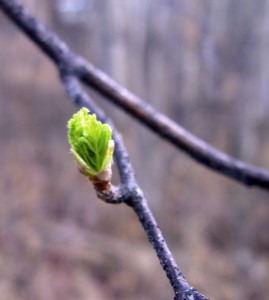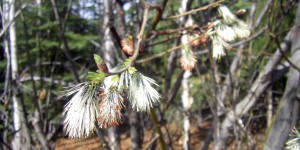Fairbanks trees primed for early leaf out
May 3, 2010
Marie Gilbert
907-474-7412
5/3/10
Fairbanks is on the verge of having another early spring leaf out, according to University of Alaska Fairbanks biologist Eugenie Euskirchen. Chilly temperatures last Friday put the brakes on the area’s bud burst, but just one more warm day, she said, and the hills will turn green with unfurled aspen, birch and willow leaves.

The earliest leaf out according to Euskirchen’s records was May 1, 1995. If temperatures hadn’t dropped last Friday, spring 2010 might have been a record-breaker. Euskirchen studies phenology, or how the timing of seasons affects plants and animals, and is the keeper of the long-term plant phenology records for UAF’s Bonanza Creek Long-Term Ecological Research program.
Euskirchen is looking to see if there’s a long-term trend toward earlier greening in Alaska. “It means the plants are taking up carbon dioxide earlier in the spring and are consequently more productive,” she said. “From that perspective, it’s a negative feedback to climate warming.”
Unfortunately, early greening doesn’t take up enough carbon dioxide to offset the many factors that contribute to climate warming.
“If snow was still covering the ground, it would reflect the sun’s heat back into space and that would be better, a stronger negative feedback to climate change than early uptake of carbon dioxide due to early leaf out,” Euskirchen said.
Part of the reason the leaves are coming out early is that the snow melted sooner this year. When the snow is gone, the darker ground absorbs heat, which raises soil temperatures and air temperatures for several hundred feet above the ground. Warmer temperatures mean buds develop and leaves open more quickly.

While Euskirchen checks the tree buds by her house daily, she relies on Ted Fathauer, lead forecaster for the National Weather Service in Fairbanks, to determine the exact day bud burst occurs. “There’s a certain color of green the Chena hills have to be before Ted considers it leaf out,” Euskirchen said.
If warmer temperatures continue to occur earlier in the spring, it’s possible that plants could expand their range.
“We’re seeing an increased amount of tall shrubs in the tundra,” said Euskirchen.
Early leaf out can also have negative consequences for plants. If springtime temperatures drop below freezing, that can kill leaves. While some trees can grow new leaves, that regrowth can stress trees, leaving them vulnerable to insects and herbivores.
Euskirchen uses phenological data from Fairbanks, Barrow, Toolik Field Station on the North Slope, the Seward Peninsula and other Alaska communities in her ecosystem modeling research at UAF’s Institute of Arctic Biology.
“Understanding how carbon and nitrogen move through plants and soils is a way of telling how the environment is changing and how it may respond in the future to changing climate,” she said.
ADDITIONAL CONTACTS: Eugenie Euskirchen, IAB research assistant professor, 907-474-1958, seeuskirchen@alaska.edu.
| Year | Date of bud burst |
| 1976 | May 4 |
| 1977 | May 18 |
| 1978 | May 6 |
| 1979 | May 5 |
| 1980 | May 5 |
| 1981 | May 6 |
| 1982 | May 20 |
| 1983 | May 11 |
| 1984 | May 16 |
| 1985 | May 23 |
| 1986 | May 21 |
| 1987 | May 8 |
| 1988 | May 10 |
| 1989 | May 18 |
| 1990 | May 9 |
| 1991 | May 7 |
| 1992 | May 26 |
| 1993 | May 2 |
| 1994 | May 4 |
| 1995 | May 1 |
| 1996 | May 14 |
| 1997 | May 7 |
| 1998 | May 5 |
| 1999 | May 12 |
| 2000 | May 16 |
| 2001 | May 18 |
| 2002 | May 19 |
| 2003 | May 8 |
| 2004 | May 5 |
| 2005 | May 4 |
| 2006 | May 7 |
| 2007 | May 4 |
| 2008 | May 12 |
| 2009 | May 3 |


